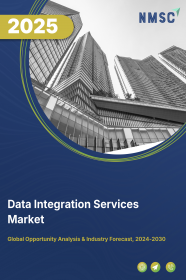
Data Integration Services Market by Component (Tools and Services), by Application (Marketing, Sales, Operations, Finance, and Human Resources), by Deployment (On-premise and Cloud), by Organization Size (Small, Medium Enterprises, and Large Enterprises), and by Industry Vertical – Global Opportunity Analysis and Industry Forecast 2023-2030
Market Definition
The Data Integration Services Market size was valued at USD 12.26 billion in 2022 and is predicted to reach USD 30.22 billion by 2030 with a CAGR of 11.9% from 2023-2030.
Data integration refers to the process of combining and merging data from different sources into a unified and coherent format. It involves gathering data from various systems, databases, applications, or files, and transforming it to ensure compatibility and consistency. The purpose of data integration is to create a comprehensive view of the information, enabling organizations to make informed decisions, gain valuable insights, and drive effective business strategies. Thus, by integrating data, organizations can overcome data silos, eliminate redundancy, and establish a holistic and centralized data environment that supports better data management, analysis, and reporting.
Market Dynamics and Trends
The increasing number of data sources such as internal systems that includes ERP and CRM and external sources like web and cloud data is driving the growth of the data integration market. Industries including healthcare & life sciences, BFSI and many others can benefit from data integration as these solutions help them to improve their understanding of data, make better decisions, and stay ahead of the competition.
In addition, data integration allows low maintenance costs by using an efficient integration platform, and it also helps organizations to manage their resources effectively. The market for data integration is expanding as more businesses consolidate their multiple software systems into a single integrated solution. This consolidation enables organizations to free up resources that can be redirected towards areas such as innovation and business growth.
Moreover, rising adoption of modern data integration tools that offers advanced transformation capabilities and a wide range of features, such as data capture, data profiling, data quality, governance, and metadata management are expected to propel the growth of the market during the forecast period.
However, the lack of expertise and risk of data alteration by the hackers are the factors that restrain the growth of the market. On the contrary, the implementation of advanced technologies, such as cloud computing, big data, machine learning, and data lakes that make it easier to store, process, analyze, and manage data, which can lead to improved data integration outcomes is expected to create lucrative opportunities for the data integration market players in future.
Market Segmentations and Scope of the Study
The data integration services market is segmented based on component, application, deployment, organization size, industry vertical and region. Based on the component, the market is classified into tools and services. Based on the application, the market is divided into marketing, sales, operations, finance, and human resources. Based on the deployment, the market is categorized into on-premise and cloud. Based on the organization size, the market is bifurcated into small and medium enterprises and large enterprises. Based on the industry vertical, the market is segmented into healthcare and life sciences, BFSI, manufacturing, retail and consumer goods, IT and telecom, media and entertainment, energy and utilities, government and defense, and others. The region breakdown and analysis of each of the aforesaid segments include regions such as North America, Europe, Asia-Pacific, and RoW.
Geographical Analysis
North America region is expected to hold the dominant share of data integration services market size and is expected to continue dominating the market during the forecast period. The market for data integration is experiencing growth due to the increasing availability of data integration solutions integrated with AI technologies. The launch of these AI-powered data integration solutions is driving the market forward, as businesses recognize the benefits of combining data integration capabilities with advanced artificial intelligence techniques.
For instance, in February 2023, Informatica launched of a new free, AI-powered data integration solution called Cloud Data Integration-Free (CDI-Free). CDI-Free is designed to help data practitioners and non-technical users build data pipelines within minutes. It includes a number of features, such as AI-powered data profiling, auto-mapping, real-time data integration, and others.
Also, the presence of top companies, including Informatica, Talend, Microsoft, IBM, Boomi, and others engaged in various business strategies such as business expansion propels the growth of the market. For instance, in April 2023, Boomi, a US-based data integration company plans to expand into Canada, starting with a new office in Vancouver. Boomi's data integration solutions help businesses to connect and manage their data from a variety of sources. The company's solutions are used by businesses in a variety of industries, including financial services, healthcare, and retail. Through this expansion into Canada, the company plans to broader its growth.
On the other hand, Asia-Pacific has also witnessed steady growth in the market owing to the penetration of data integration in the healthcare sector in improving patient care, increasing efficiency, reducing costs, improving research, and enhancing compliance. As the healthcare industry continues to evolve, data integration will play an increasingly important role in boosting the growth of the industry. For instance, in August 2022, the government of Indonesia launched a new healthcare data integration platform called SATUSEHAT. The platform is designed to help connect and integrate data from different healthcare sources, such as hospitals, clinics, and laboratories. This will allow healthcare providers to have a complete view of a patient's health history, which can help to improve the quality of care.
Competitive Landscape
The data integration services market comprising of various market players such as SAS, Informatica Corporation, Qlik, Microsoft Corporation, IBM Corporation, Oracle Corporation, SAP SE, Syncsort, Alteryx, Denodo Technologies, and others. These market players are adopting various product launches and acquisition of business across various regions to maintain their dominance in the data integration.
For instance, in June 2023, Informatica introduced SuperPipe, a faster data integration and replication solution for Snowflake, delivering up to 3.5x faster performance. It utilizes Snowflake's parallel processing capabilities and is scalable for various use cases including data warehousing and data lakes. SuperPipe is aimed at enhancing the performance and efficiency of data integration processes for businesses.
Moreover, in May 2023, Qlik, a cloud data analytics company acquired Talend, a data integration and preparation solutions provider. This acquisition will allow Qlik to offer a comprehensive data management solution to businesses. The combined company will be well-positioned to capitalize on the growing demand for enterprise data management solutions.
Key Benefits
-
The report provides quantitative analysis and estimations of the data integration services market from 2023 to 2030, which assists in identifying the prevailing market opportunities.
-
The study comprises a deep dive analysis of the data integration services market including the current and future trends to depict prevalent investment pockets in the market.
-
Information related to key drivers, restraints, and opportunities and their impact on the data integration services market is provided in the report.
-
Competitive analysis of the players, along with their market share is provided in the report.
-
SWOT analysis and Porters Five Forces model is elaborated in the study.
-
Value chain analysis in the market study provides a clear picture of roles of stakeholders.
Key Market Segments
By Component
-
Tools
-
Services
By Application
-
Marketing
-
Sales
-
Operations
-
Finance
-
Human Resources
By Deployment
-
On-Premise
-
Cloud
By Organization Size
-
Small and Medium Enterprises
-
Large Enterprises
By Industry Vertical
-
Healthcare and Life Sciences
-
BFSI
-
Manufacturing
-
Retail and Consumer Goods
-
IT And Telecom
-
Media and Entertainment
-
Energy and Utilities
-
Government and Defense
-
Others
By Region
-
North America
-
U.S.
-
Canada
-
Mexico
-
-
Europe
-
UK
-
Germany
-
France
-
Spain
-
Italy
-
Netherlands
-
Denmark
-
Finland
-
Norway
-
Sweden
-
Russia
-
Rest of Europe
-
-
Asia-Pacific
-
China
-
Japan
-
India
-
South Korea
-
Australia
-
Indonesia
-
Singapore
-
Taiwan
-
Thailand
-
Rest of Asia-Pacific
-
-
Rest of World
-
Latin America
-
Middle East
-
Africa
-
Key Players
-
SAS
-
Informatica Corporation
-
Qlik
-
Microsoft Corporation
-
IBM Corporation
-
Oracle Corporation
-
SAP SE
-
Syncsort
-
Alteryx
-
Denodo Technologies




















 Speak to Our Analyst
Speak to Our Analyst

























